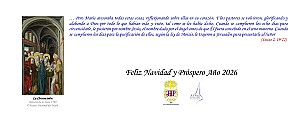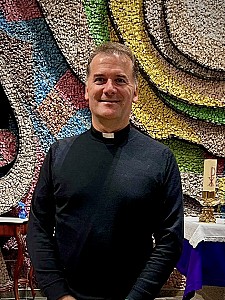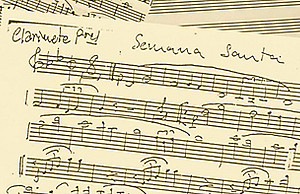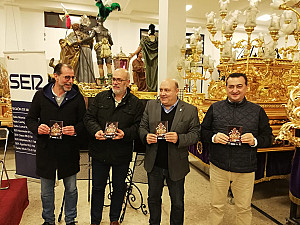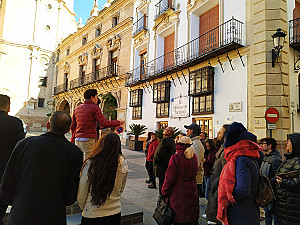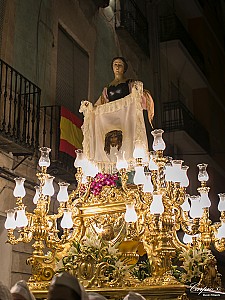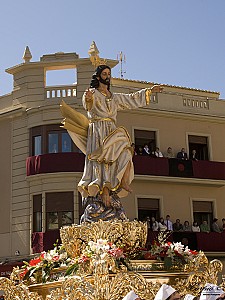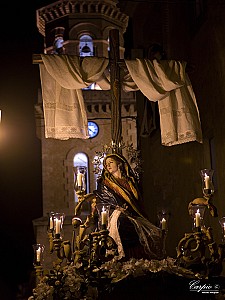| Vox populi |
| La Verónica |
| Origen y constitución |
| Se constituye en 1892 |
| Los primeros Estatutos conservados datan de 1892 |
| Día, Procesión y Paso |
| Miércoles Santo en la Procesión General con la Santa Verónica |
| Viernes Santo en la Procesión del Penitente con la Santa Verónica |
| Viernes Santo en la Procesión del Santo Entierro con Nuestra Señora de la Amargura |
| Domingo de Resurrección en la Procesión del Resucitado con La Ascensión |
Nace esta Cofradía como consecuencia del gran impulso que se le imprimen a nuestras Procesiones en las últimas décadas del siglo XIX. Su fecha de constitución ha llegado a nosotros, curiosamente, a través de una publicación local del 15 de mayo de 1892 que dice así: "En la Junta General Preparatoria celebrada el día doce, fueron aprobados los Estatutos de la nueva Cofradía creada en esta Villa, a la Matrona de Jerusalén, Santa Verónica. Las primeras gestiones hechas han sido, encargar dicha Imagen a uno de los escultores que comparten las glorias de este arte con Benllure, tan reconocidos y admirados en el mundo artístico".
La Imagen aparece en Cieza dos años después, en 1894, como recoge bajo el título de 'La nueva Cofradía' la crónica de El Orden del once de marzo de ese año: "El domingo por la tarde fue llevada procesionalmente desde la casa de D. Juan Marín al Convento de Santa Clara, y después a la Iglesia Parroquial, la Imagen de Santa Verónica. La Camarera de esta hermosa Imagen es la distinguida señora Dña. Visitación Aguado de Marín, la que recibió justísimas felicitaciones por el gusto exquisito y la riqueza con que iba ataviada la Santa Verónica. Un gentío inmenso, a cuya cabeza iba lo más distinguido de Cieza, seguía al Trono donde iba colocada la nueva Imagen. La música del Maestro León, con sus acordes, los cohetes y las colgaduras con que estaban engalanados los balcones de la carrera, le daban al acto todo el aspecto de las grandes solemnidades. Con la mayor solemnidad celebró el martes pasado su primera función religiosa la Cofradía de Santa Verónica erigida canónicamente en la Iglesia Parroquial. Ocupó la sagrada cátedra nuestro celosísimo y muy amado Sr. Cura Párroco, Dr. D. Francisco Vigueras, quien pronunció un sermón elocuente como todos los suyos, acerca de la obligación que voluntariamente aceptaban los nuevos Cofrades de imitar muy especialmente el acto de aquella noble matrona, limpiando el rostro del Señor con las manchas con que tratan de afearlo los modernos judíos, o sea, los blasfemos, los sacrílegos, herejes y libres pensadores de nuestro tiempo. La parte musical estuvo a cargo de la Orquesta que dirige el Maestro León, la cual interpretó un lindo motete compuesto expresamente para dicho acto por el citado maestro, letra de nuestro respetable amigo y querido D. Ramón Capdevila. La Imagen de la Verónica recientemente adquirida por la nueva Cofradía es una acabada obra del afamado escultor murciano, Sr. Sánchez Araciel. El lienzo que representa la Santa Faz es una de las mejores producciones debidas al inspirado pincel del Sr. Ruiz de Sardes, generoso obsequio hecho a la Cofradía por el Sr. D. Antonio Cánovas y Vallejo, ex-diputado a Cortes por este distrito y a quien la nueve Cofradía debe profunda gratitud...".
A la Imagen de Sánchez Araciel debemos añadir el trono, tallado posiblemente por José Izquierdo y dorado por Ignacio Amoraga, ambos ciezanos.
Desde su primera incorporación a nuestros Desfiles, el Jueves Santo en la Procesión General y el Viernes Santo en la mañana en la del Penitente, la Cofradía estuvo vinculada a la familia Buitrago (D. Manuel Buitrago, Hermano-Mayor, en 1914 fue uno de los constituyentes de la Junta de Hermandades Pasionarias de Cieza), a la que pasó la Camarería de la Cofradía a la muerte de Dña. Visitación Aguado en 1917. En los Desfiles de aquellos años al frente de la Cofradía junto al guión se colocaba una larga trompeta montada sobre un carro pequeño que tocaba para advertir a las gentes que se dispusieran a ver pasar la Procesión; de ahí que se pueda justificar el hecho de que en la Procesión General de 1920, independientemente del sitio asignado a la Imagen, su Cofradía desfile a la cabeza de todo el cortejo. Ese mismo año se le aprueba que su Paso Titular vuelva a desfilar en la Procesión del Santo Entierro en la que había figurado esporádicamente años atrás -en ella seguirá desfilando hasta que la Cofradía lo sustituya en 2009 por el Paso 'Nuestra Señora de la Amargura'- y por la misma época comienza a participar también en la Procesión del Resucitado, en la que no dejará de hacerlo en la misma hasta que en 2005 sea sustituido por 'La Ascensión'.
Las huelgas generales de los años veinte ponen en peligro la continuidad de la Cofradía, y así en 1929 su Junta General determina que se entregue la Imagen con todos sus enseres al cura-párroco de la Iglesia de Nuestra Señora de la Asunción para que este a su vez la ponga a disposición de la Cofradía que se constituya en un futuro. No obstante el Hermano Mayor, Sr. Buitrago Villa, manifestó su intención de renovar y reorganizar la Cofradía en breve plazo, saliendo en procesión ese año, anulando así el acuerdo anterior y dejando para después de Semana Santa la elección de Junta Directiva, Camarera y lugar y custodia de la Imagen, trono y enseres de la misma. Ese mismo año, tal como relata un artículo del periódico 'Cieza' la Cofradía cambia los colores de sus túnicas, en las que combinaba el blanco y el verde, así como la hechura de las mismas tomando como modelo las que anteriormente había introducido la Cofradía del Santísimo Cristo de la Agonía a la usanza de Sevilla; y en 2008 incorporará a su vestuario un medallón con su emblema.
Tras la Guerra Civil, a la que la Imagen había sobrevivido en casa de D. Manuel Buitrago, desfila de nuevo en 1942 merced a una comisión formada al efecto que reforma el trono y la Imagen, y que además se propuso adquirir lámparas para el alumbrado eléctrico, el arreglo del guión y el adorno del Paso con flor natural. No obstante, el entusiasmo mostrado por los miembros de la comisión no pudo evitar cierto fracaso un año después, desembocando esta situación nuevamente en la reorganización de la Cofradía en el año 1945, siendo Presidente D. José Molina Rodríguez.
Ese mismo año de 1945 la Cofradía entra en contacto con el escultor Francisco Palma Burgos y le encarga por valor de ocho mil pesetas la restauración de Imagen y trono, así como el dorado completo de este. Un año después vuelve a desfilar el Paso de la Santa Verónica, que no lo había hecho en los tres años anteriores, y se nombra Camarera a Dña. Josefina Pérez de Tarazona. En esas fechas, el paño con la Santa Faz debido a Ruiz de Sardes, es sustituido por otro obra de Benedito, y éste a su vez alternado desde 1992 por otro regalado por la familia Marín Oliver obra de la pintora ciezana María Jesús Castañeda.
De la década de los 70 es el estandarte bordado en oro y pedrerías por la cartagenera Concha Escámez. En los años que siguen se suceden al frente de la Cofradía D. Adriano Cano Gómez, D. Isidro Herrero Camacho y D. Pedro Marín Ordóñez. Desde 1989 y hasta 1995, bajo la Presidencia de D. Francisco Martínez Camacho, la cofradía concluye en 1992 la tarea de recuperar su tradicional vestuario y sustituye los viejos báculos del Tercio de nazarenos por otros nuevos realizados por el orfebre ciezano Diego Penalva en 1994.
En 1997, siendo presidente D. Antonio Villa Aroca, Javier Bernal Casanova restaura la Imagen y Diego Penalva los faroles de Tercio; y en 1999 se vuelve a dorar, esta vez en oro fino, el trono, cuyas galas serán sustituidas por otras nuevas confeccionadas en terciopelo por Hermanas de la Cofradía en 2008, y se restauran el paño y pintura de la Santa Faz de Benedito; ambas actuaciones son llevadas a cabo por Javier Bernal Casanova.
Desde el año 2005 la Cofradía, bajo la Presidencia de D. Matías Ríos Saorín, desfila en la Procesión de Jesús Resucitado con el Paso 'La Ascensión' en sustitución del titular, provisionalmente y hasta 2008 en el trono de este. Se trata de un conjunto integrado por la Imagen de Nuestro Señor en su Ascensión, tallada en madera por el escultor sevillano Miguel Bejarano, para la que se hicieron en 2006 unas potencias de oro en los talleres de orfebrería Orovio de la Torre de Ciudad Real, y por un trono, tallado en madera y dorado en plata a la korla, obra del artesano local Bonifacio Pérez Ballesteros, que se terminó para la Semana Santa de 2008 junto con el correspondiente juego de puntas de vara, también talladas en madera y doradas; completan el trono unas galas de terciopelo bordadas en oro en 2008 por Hermanas de la Cofradía y un portacampana realizado también en 2008 por Bonifacio Pérez Ballesteros -la talla de madera- y por Antonio Jesús Yuste Navarro –la Imagen del ángel que sujeta la campana-.
En 2009, ya bajo la presidencia de Dª Josefa García Guardiola, el escultor cordobés Francisco Romero Zafra talla en madera, para la salida procesional de la Cofradía en la Procesión del Santo Entierro, la Imagen de Nuestra Señora de la Amargura, una escultura policromada de la Virgen con una mantilla de encaje en las manos y sentada junto a la cruz, de la que cuelga el sudario, para la que el propio escultor diseña una aureola de plata. El trono sobre el que desfila, iniciado en 2009, es una obra tallada en madera con detalles en plata en los talleres cordobeses de los hermanos Higuera González, y se completa con el correspondiente juego de galas de terciopelo confeccionadas por las Hermanas de la Cofradía.
Fotografías de Manuel Carpio.
© Junta de Hermandades Pasionarias de Cieza
